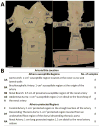Chronic endoplasmic reticulum stress activates unfolded protein response in arterial endothelium in regions of susceptibility to atherosclerosis
- PMID: 19661457
- PMCID: PMC2746924
- DOI: 10.1161/CIRCRESAHA.109.203711
Chronic endoplasmic reticulum stress activates unfolded protein response in arterial endothelium in regions of susceptibility to atherosclerosis
Abstract
Rationale: Endothelial function and dysfunction are central to the focal origin and regional development of atherosclerosis; however, an in vivo endothelial phenotypic footprint of susceptibility to atherosclerosis preceding pathological change remains elusive.
Objective: To conduct a comparative multi-site genomics study of arterial endothelial phenotype in atherosusceptible and atheroprotected regions.
Methods and results: Transcript profiles of freshly isolated endothelial cells from 7 discrete arterial regions in normal swine were analyzed to determine the steady state in vivo endothelial phenotypes in regions of varying susceptibilities to atherosclerosis. The most abundant common feature of the endothelium of all atherosusceptible regions was the upregulation of genes associated with endoplasmic reticulum (ER) stress. The unfolded protein response pathway, induced by ER stress, was therefore investigated in detail in endothelium of the atherosusceptible aortic arch and was found to be partially activated. ER transmembrane signal transducers IRE1alpha and ATF6alpha and their downstream effectors, but not PERK, were activated concomitant with a higher transcript expression of protein folding enzymes and chaperones, indicative of ER stress in vivo.
Conclusions: The findings demonstrate the prevalence of chronic endothelial ER stress and activated unfolded protein response in vivo at atherosusceptible arterial sites. We propose that chronic localized biological stress is linked to spatial susceptibility of the endothelium to the initiation of atherosclerosis.
Conflict of interest statement
Figures





References
-
- Schwartz CJ, Mitchell JR. Observations on localization of arterial plaques. Circ Res. 1962;11:63–73. - PubMed
-
- Caro CG, Fitz-Gerald JM, Schroter RC. Arterial wall shear and distribution of early atheroma in man. Nature. 1969;223:1159–1160. - PubMed
-
- Gimbrone MA, Jr, Anderson KR, Topper JN, Langille BL, Clowes AW, Bercel S, Davies MG, Stenmark KR, Frid MG, Weiser-Evans MC, Aldashev AA, Nemenoff RA, Majesky MW, Landerholm TE, Lu J, Ito WD, Arras M, Scholz D, Imhof B, Aurrand-Lions M, Schaper W, Nagel TE, Resnick N, Dewey CF, Gimbrone MA, Davies PF. Special communicationthe critical role of mechanical forces in blood vessel development, physiology and pathology. J Vasc Surg. 1999;29:1104–1151. - PubMed
-
- Ross R. Atherosclerosis--an inflammatory disease. N Engl J Med. 1999;340:115–126. - PubMed
-
- Aird WC. Phenotypic heterogeneity of the endothelium: II. Representative vascular beds. Circ Res. 2007;100:174–190. - PubMed
Publication types
MeSH terms
Substances
Grants and funding
LinkOut - more resources
Full Text Sources
Other Literature Sources
Medical

